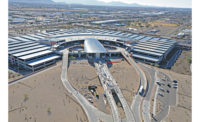After two years of coping with lockdowns, social distancing, teleconference learning curves and virus variants, construction and design firms find themselves adapting to yet another pandemic-related challenge—safely returning employees to the office while accommodating a newfound appreciation and desire for the benefits of working remotely.
While the pandemic demonstrated the viability of sustaining operations and collaborating across a widely dispersed workforce, few companies appear eager to make it permanent.
Industry human resources consultant Juli Smith says only a small percentage of businesses are continuing all-remote operations, citing personnel drawbacks such as limits on supervising the training and development of younger employees and the need to fully integrate newly onboarded workers into project teams. “Then there’s the fact that for many of us, the people we work with are a big reason why we like our jobs,” Smith adds.
Still, most firms are not simply flipping the switch back to 2019. For all its limitations, remote work has been embraced by many workers with lingering health and safety concerns as well as by those whose personal responsibilities, such as child those whose personal responsibilities, such as child care, have changed during the pandemic.
Their expectations have changed as well, Smith adds, and at a time when industry talent is at a premium, it’s the rare organization that can afford to disregard them.
“There is a new paradigm,” she says, “and it’s driven by employees.”
Balancing Act
The solution for many firms is a hybrid work environment—one that offers a structure to combine a degree of in-person presence for most employees while retaining flexible elements of pandemic-era practices.
For firms such as New York City-based engineer Jaros, Baum & Bolles (JB&B), implementing hybrid protocols has been an iterative process shaped by both business needs and employee input, with the nimbleness to rework it when new COVID-19 variants and rules emerge.
“It was always about safety, and conveying that message has been important from the outset,” says JB&B human resources director Aimee Totaro, citing measures such as vaccination requirements and a recently relaxed mandate on mask wearing in the office. “All those protocols have helped build trust with employees,” she says.
To encourage more employees to return to the office, JB&B now offers incentives such as weekly onsite events and gradually transitioning what had been virtual meetings to in-person settings. The company also has devised new rules for what’s expected of managers and employees in both settings.
Totaro adds that accommodating employee needs as much as possible while still running a business “is a little bit of a balancing act.”
Messaging also has been important for Herndon, Va.-based engineering firm ATCS PLC, which has eschewed the term “return to work” in favor of what human resources vice president Sherri Huntley calls “purposeful” onsite activities.
“The expectation is that employees will come in at least a few days a week after consulting with a manager,” Huntley explains. “But those will be times when their team is collaborating or really engaged in project and operations work.”
The further away we get from an old command-and-control approach, the more things will keep evolving—and at a faster pace than before.
Julie Kellman, vice president of human resources, Pepper Construction Group
ATCS also is reevaluating workspaces to support the “purposeful” concept. “Reworking seating arrangements, types of meeting rooms and group get-together spaces sends a message that employees are here to collaborate and engage with others,” Huntley says.
For contractor Hourigan in Richmond, Va., the hybrid work policy required evaluating each employee’s role on a project—what was needed either at the office or the jobsite and the extent to which those functions could be performed remotely.
“Because each site is different, we have to adjust our models with what our clients’ standards are and what they expect out of us,” says Sally Tate, Hourigan vice president of people strategies. “Collaboration was always at the forefront, and finding the best work model to do that for a particular project changed several times during the pandemic.”
So far, hybrid work environments appear to be fulfilling firms’ expectations. Huntley reports that the number of ATCS employees spending time in the office has doubled during the first part of 2022, a figure the firm hopes to increase with a short-term program of shared meals and happy hours. While there was some initial skepticism among managers, most have come on board.
“Some are used to a certain formality, and typically don’t want to be constricted, but they’ve embraced it,” she says.
“It’s really about getting the work done,” observes Julie Kellman, vice president of human resources for Pepper Construction Group, Chicago, whose firm has long had a performance-based policy that allows employees to work away from the office or jobsite trailer.
Kellman says in shaping its hybrid work policy, the firm looked at a whole range of options, with varying degrees of structure and onsite attendance. Pepper finally settled on requiring employees to be in the office four days a week.
“The challenge has been getting everyone to understand the difference between a policy that applies to all, and one that is earned and coordinated with managers,” Kellman says, adding that employees also need to provide some flexibility of their own, such as being present for a client meeting on a day he or she previously arranged to work remotely.
Likewise, “managers have to be accountable for making sure an employee who needs to be there for something, is there,” she says.
A More Flexible Future
As is appropriate for an arrangement defined by variation, hybrid work environments are likely to evolve in step with changing employee preferences. Smith says each firm will have to decide for itself how much flexibility to offer employees, particularly those with coveted skills.
“If someone—even a younger engineer—wants to work remotely, a firm may have to accommodate that request or else risk losing” the employee, she says. “It’s not a one-size-fits-all approach, and you can’t be afraid to make exceptions.”
Smith cites unnamed “conservative” firms that three years ago would never have considered remote and hybrid work environments. Driven to make changes because of talent shortages, “they’ve accepted and embraced it.”
A generational shift in the workforce also will likely influence the evolution of hybrid schedules.
“It’s an ever-changing environment, and you have to change with it in order to meet needs of your employees,” says Tate. “That’s where we’re focused—continuing to stay in front of what people need, how they can be supported and how their work life can help support their home life.”
Kellman agrees, noting that “the further away we get from an old command-and-control approach, the more things will keep evolving—and at a faster pace than before.” She adds that the key to keeping the evolution of hybrid work policies on track is making it clear that two-way communication is an integral part of that environment.
“Management needs to send the right message, and employees need the psychological safety to speak up and say what is and isn’t working,” she says. “Then management needs to do something about it.”



